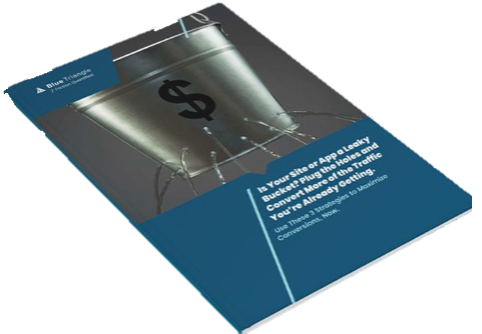Website speed directly impacts the user experience and business outcomes, like search engine rankings, conversion rates, and revenue (research confirms it).
When nearly 70% of consumers say page speed impacts their purchasing decisions, online businesses have noticed.
That's one reason website speed optimization is one of the biggest priorities for teams looking to deliver a frictionless digital experience and build customer trust and loyalty.
But site speed is widely misunderstood.
In fact, Lance Ullom, CEO of Blue Triangle, recently gave an interview on what the industry often gets wrong about site speed and how brands should be doing things differently to deliver a frictionless experience.
How fast is fast enough? What is a good site speed? What pages should you speed up? Or what if you made optimizations, but your site is still slow, what the heck should you fo?
Answering these questions can be complicated. So lets start off by clearing up some rumors surrounding site speed.
Here are 7 common myths about website speed.
Myth #1: The faster, the better.
While it's true that faster-loading websites tend to provide a better user experience, there is a point of diminishing returns.
Research suggests that users expect a webpage to load within two seconds, and 40% of consumers will abandon a site that takes more than 3 seconds to load.
However, striving for near-instant load times may not always be practical or necessary, especially for content-rich websites. Sites are often made faster at the expense of the user experience.
On an episode of The Frictionless Experience, Kenny Goldshvartz from Wyndham Hotels & Resorts shares more on why speed alone doesn't make a customer experience frictionless.
Myth #2: Two seconds is the golden rule.
While two seconds is often cited as an ideal load time, it's important to consider the context. Factors such as the complexity of the webpage, network conditions, and user expectations can vary.
According to an Amazon study, for example, they found that every 100 milliseconds of added page slowness cost them 1% in sales, which means billions of dollars. Every site and customer base are not exactly like Amazon's, though.
By analyzing hundreds of sites, thousands of pages, and millions of conversion events, we've uncovered that the optimum speed varies by page and site. Which means, you don't need to obsess over Amazon's numbers, you need to know your unique numbers. The only way to figure that out is by calculating the Conversion Rate Curve for each page of your site.
Myth #3: Load time is the only important metric.
While load time is an essential metric, it's not the sole factor to consider. User experience metrics like time to interactive, Core Web Vitals, and perceived performance are equally important.
Users perceive a webpage as fast if it shows visible content and becomes interactive quickly, even if some non-essential elements continue to load in the background. Simply, perceived performance is how fast your site feels like it loads from the user's perspective, not from a monitoring tool.
Myth #4: Third-party scripts and tools don't affect load times.
Third-party scripts, such as social media widgets or analytics trackers, can significantly impact website performance. Each additional script adds extra HTTP requests and potential delays if not properly optimized.
It's crucial to evaluate third-party tools and employ asynchronous loading techniques to prevent them from negatively impacting the overall load time and user experience.
Some cloud observability and digital monitoring tools can actually hinder page performance, adding overhead to your site and slowing it down. Careful implementation and choosing the right tools can minimize their impact on page performance.
The key is to strike a balance between gathering valuable insights and maintaining optimal speed.
Myth #5: Only the homepage needs to be fast.
Or only the checkout page. Or (insert page name here). The truth is you should prioritize the pages with the costliest friction to optimize speed and the user experience.
The customer journey isn't always linear, and visitors can come through several paths, such as landing on certain pages through search engine results or referral links or because of your marketing campaign efforts.
Neglecting the speed of inner pages can lead to high bounce rates and dissatisfied visitors. Optimize critical pages and frequently visited sections to ensure a consistently fast user experience throughout your website.
Myth #6: Website speed is only the responsibility of developers.
While developers and DevOps teams play a vital role in optimizing website speed, it's a collective effort that involves multiple teams. But it's no secret that different business stakeholders also have different priorities when it comes to your website.
This can lead to finger-pointing because so many teams could modify your site. Which means it could be Marketing adding a new tag, Product rolling out an updated feature, Development injecting a code error, or some other issue, that causes friction.
To overcome this, successful businesses have adopted a performance-driven culture of Continuous Experience Optimization to remove the blame game across departments. Embracing a cross-functional approach and prioritizing user experience for all teams can improve overall user experience and business outcomes.
Myth #7: Website speed optimization is a one-time project.
Delivering a fast website goes beyond one-time optimizations or siloed team projects. It should be a continuous effort across all teams and stakeholders because, after all, digital properties are being updated continuously, and every update can negatively impact performance.
Today, leading companies in every industry who are winning in digital have realized that Continuous Experience Optimization is needed to create frictionless digital experiences that build customer trust and loyalty.
Regular performance monitoring, analysis, and iterative improvements are necessary to keep pace with evolving user expectations. For strategies on how to adopt Continuous Experience Optimization (CEO) to deliver frictionless digital experiences, increase revenue, and boost conversions, read our ungated CEO Hacks eBook.
Are you wasting time and money speeding up the wrong pages?
By dispelling these common myths about website speed, you can adopt a more holistic and informed approach to optimizing your digital presence.
Remember, website speed is not just a technical concern but a vital aspect of delivering remarkable, frictionless user experiences. By prioritizing the user experience, embracing continuous optimization, and involving all teams, your high-performing website can attract, convert, and retain more customers.
Not sure where to begin or what pages to optimize? Request a Friction Quantified Analysis, and we can tell you the friction cost on your site so you can prioritize solutions for maximum impact.

During the holiday rush, every shopper matters
Optimize the customer journey before the eCommerce event of the year.

.jpg)

